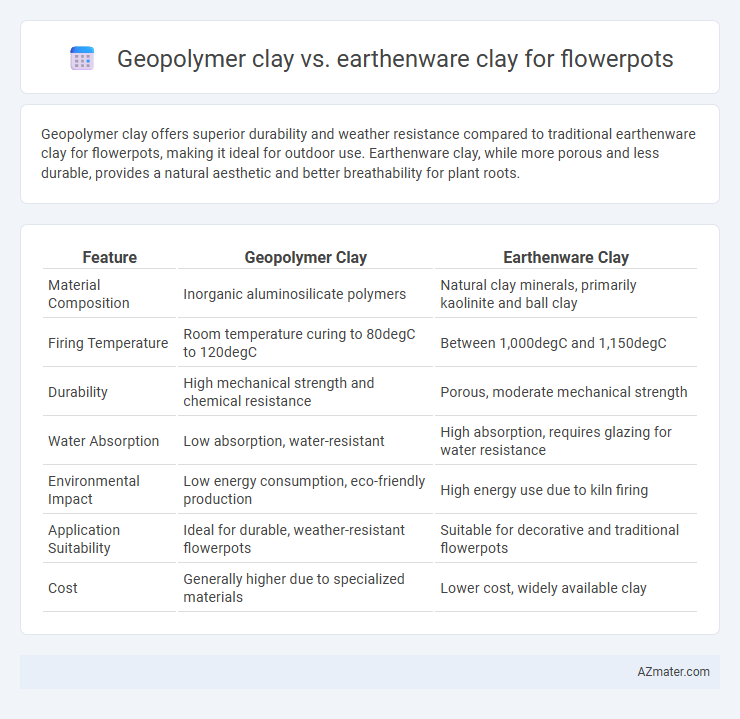Geopolymer clay offers superior durability and weather resistance compared to traditional earthenware clay for flowerpots, making it ideal for outdoor use. Earthenware clay, while more porous and less durable, provides a natural aesthetic and better breathability for plant roots.
Table of Comparison
| Feature | Geopolymer Clay | Earthenware Clay |
|---|---|---|
| Material Composition | Inorganic aluminosilicate polymers | Natural clay minerals, primarily kaolinite and ball clay |
| Firing Temperature | Room temperature curing to 80degC to 120degC | Between 1,000degC and 1,150degC |
| Durability | High mechanical strength and chemical resistance | Porous, moderate mechanical strength |
| Water Absorption | Low absorption, water-resistant | High absorption, requires glazing for water resistance |
| Environmental Impact | Low energy consumption, eco-friendly production | High energy use due to kiln firing |
| Application Suitability | Ideal for durable, weather-resistant flowerpots | Suitable for decorative and traditional flowerpots |
| Cost | Generally higher due to specialized materials | Lower cost, widely available clay |
Introduction to Flowerpot Clay Types
Geopolymer clay and earthenware clay are two popular materials used for flowerpots, each offering unique properties. Geopolymer clay is a synthetic, eco-friendly alternative known for its high durability, chemical resistance, and rapid curing at low temperatures, making it ideal for modern, sustainable gardening. Earthenware clay, a traditional natural material, provides excellent breathability and moisture retention, fostering healthy root development but requires high-temperature firing for strength and durability.
What is Geopolymer Clay?
Geopolymer clay is an advanced, eco-friendly material composed of aluminosilicate sources activated by alkaline solutions, offering high durability and weather resistance ideal for flowerpots. Unlike traditional earthenware clay, geopolymer clay cures at room temperature through a chemical process without requiring firing, reducing energy consumption during production. Its superior mechanical strength and resistance to water absorption make geopolymer clay a sustainable alternative for long-lasting garden pots.
What is Earthenware Clay?
Earthenware clay is a porous, low-fired clay composed mainly of natural minerals like kaolinite, quartz, and feldspar, making it ideal for traditional pottery such as flowerpots due to its breathability and water absorption properties. Unlike geopolymer clay, which is synthetic and cured through chemical reactions, earthenware clay hardens by firing at temperatures typically between 1,000degC and 1,150degC, resulting in a softer, less durable material. This natural characteristic allows for better moisture regulation in plants but requires sealing for enhanced durability and weather resistance in outdoor flowerpots.
Material Composition Comparison
Geopolymer clay consists primarily of aluminosilicate materials activated by alkaline solutions, providing a strong, heat-resistant matrix ideal for durable flowerpots. Earthenware clay is composed mainly of natural clay minerals such as kaolinite, quartz, and iron oxides, which result in a more porous, less heat-resistant material after firing. The inorganic polymer network in geopolymer clay offers superior mechanical strength and chemical resistance compared to the more traditional silicate-based structure of earthenware clay.
Durability and Weather Resistance
Geopolymer clay offers superior durability and weather resistance compared to traditional earthenware clay, making it ideal for flowerpots exposed to harsh outdoor conditions. Its inorganic polymer matrix provides high resistance to moisture, frost, and UV radiation, reducing the risk of cracking and degradation over time. Earthenware clay, while more porous and prone to chipping in extreme weather, is less durable and requires sealing to enhance its weatherproof properties.
Water Absorption and Retention
Geopolymer clay exhibits significantly lower water absorption rates compared to earthenware clay, enhancing its durability and reducing the risk of cracking in flowerpots. Its dense, non-porous structure enables superior water retention, promoting consistent moisture levels for plant roots. Earthenware clay, with higher porosity, absorbs more water but dries faster, requiring more frequent watering to maintain optimal soil hydration.
Environmental Impact and Sustainability
Geopolymer clay offers a significantly lower carbon footprint than traditional earthenware clay due to its reliance on industrial by-products like fly ash and slag, reducing the need for energy-intensive firing processes. Earthenware clay, sourced from natural clay deposits, involves extensive mining and higher firing temperatures that increase greenhouse gas emissions. Choosing geopolymer clay for flowerpots enhances sustainability by minimizing raw material depletion and reducing harmful emissions associated with conventional ceramic production.
Aesthetic Differences and Color Options
Geopolymer clay offers a modern, sleek aesthetic with smooth surfaces and uniform textures, often available in neutral grays and customizable hues through pigments, making it ideal for contemporary flowerpots. Earthenware clay provides a warm, rustic appearance with natural, earthy tones such as terracotta, red, and brown, showcasing organic variations and textures that enhance the handcrafted look. Color options in earthenware are typically achieved through natural clay bodies and glazes, while geopolymer clay allows for greater precision in color consistency and finishes.
Cost and Accessibility
Geopolymer clay tends to have higher upfront material costs compared to earthenware clay, but it offers enhanced durability and weather resistance for flowerpots. Earthenware clay is more accessible due to widespread availability and lower price points, making it a budget-friendly option for mass production. For cost-efficient gardening pots, earthenware is preferable, while geopolymer clay suits projects valuing long-term performance despite higher initial expenses.
Best Applications for Each Clay Type
Geopolymer clay excels in outdoor flowerpots due to its superior durability, weather resistance, and minimal water absorption, making it ideal for harsh environmental conditions. Earthenware clay is best suited for indoor or decorative flowerpots where its porous nature allows better aeration for plants and provides a classic, rustic aesthetic. Choosing between the two depends on whether the flowerpot needs to withstand outdoor elements or prioritize plant health and visual appeal indoors.

Infographic: Geopolymer clay vs Earthenware clay for Flowerpot
 azmater.com
azmater.com